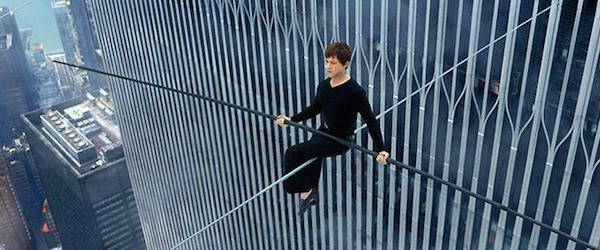How Robert Zemeckis Toed the Studio-Indie Tight Rope to Make The Walk

Producer Steve Starkey first met Robert Zemeckis in post-production on Who Framed Roger Rabbit. In his first day on the project, Starkey approached Zemeckis and told him he was there to oversee the integration of the live action and animation elements in the film.
“Good luck,” said Zemeckis.
Despite this inauspicious start to their collaboration, the two of them have been working together ever since. In fact, Starkey hasn’t worked on a project without Zemeckis in the last 29 years. Their latest film, The Walk, which recently screened in 3D at Film Independent at LACMA, follows high-wire artist Philippe Petit on his now legendary walk between the towers of the World Trade Center in 1974. Petit’s story was the subject of the 2009 Film Independent Spirit Award-winning documentary Man on Wire.
Starkey and Zemeckis have been working to bring their version of the story to life for 10 years. “Not since Forrest Gump has it taken [us] that long to get a movie launched,” said Starkey.
Starkey recalled how the two of them would be shooting other projects and Zemeckis would pull him aside and ask about their progress in lining up pitches for The Walk. “There is very little that’s going to get in the way of Bob making the movie he’s wanting to make,” said Starkey.
Forrest Gump won both gentlemen Oscar gold, but that didn’t mean selling a studio on The Walk would come easy for them. They were having a hard time getting people to understand what they wanted to do with the script alone.
“We find that a lot of people can’t read screenplays anymore,” Starkey said. So Zemeckis set about creating a pre-visualization of the film. It was an elaborate process and Petit himself was even brought on to assist in the creation of a story reel (a moving collection of storyboards for the film).
After several pitches with their new materials, Zemeckis and Starkey eventually found a producing partner in Sony Pictures. But the studios could only shell out so much cash for a film centered around tight rope walking.
“The last few movies–Flight, The Walk–are really independent movies made within the studio system. And, of course, what then you have to do is say, ‘Well, how do you make a movie that should be made for 100 million dollars for a third of that?’ Because if you don’t do that, you’re not going to make it.” And Starkey knew Zemeckis was going to make it.
They also knew it had to be in 3D. Zemeckis planned for the 3D conversion well ahead of shooting, smoothing out the transition and maximizing the impact it would have on the audience—while staying within their financial constraints. “That’s why the presentation of the film is so effective,” said Starkey, “It feels natural.”
Zemeckis’ detailed planning recalls Petit’s own scheming to cross the towers, which, in the film, plays as a high-stakes heist by an artist mad with passion. “Bob, I think, related to this project, because he’s very much–but not in an insane way–as passionate as Philippe,” Starkey said.
Starkey also shed some light on Zemeckis’ inspirations, quoting Francois Truffaut: “The best cinema is a combination of truth and spectacle.”
“In the Bob Zemeckis world,” explained Starkey, “this means he gets to the heart of his characters and tries to tell some form of human truth. And at the same time, he can’t resist presenting audiences with a gigantic spectacle.”
The Walk, which is now playing in select theaters and opens everywhere October 9, is perhaps the perfect summation of these twin aims–a fine example what Zemeckis brings to cinema.
Daniel Larios / Film Independent Blogger